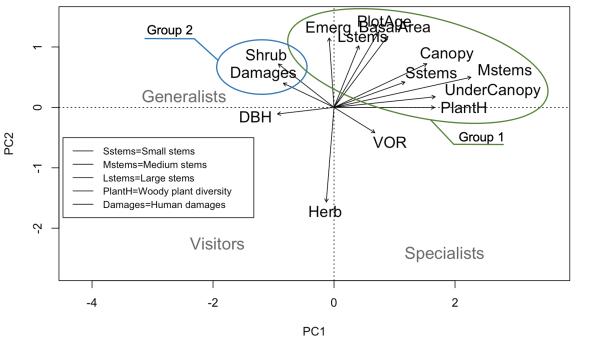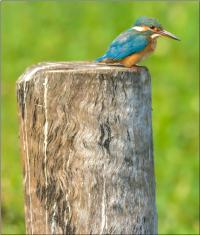Findings & Discussion
Vegetation structures divided into two groups
The results showed that the Kakamega forest could be divided into two separate groups with regard to vegetation structures. Group 1 consisted of vegetation structures associated with old, undisturbed forests such as high plot age, large basal area of woody plants, many large stems, high woody plant diversity, high VOR (open undergrowth) and high foliage coverage of the upper vertical layers (i.e. under canopy-, canopy- and emergent layer). The other group, Group 2, consisted of many human damages and high coverage of the herb- and shrub layers, which is typical in young or disturbed forests (Figure 1).
Habitat guilds
The results showed that forest specialists were more correlated to vegetation structures characteristic of old undisturbed forests (Group 1), whereas the forest generalists were more associated with the vegetation structures typical of young or disturbed forests (Group 2) (Figure 1). One typical characteristic of undisturbed rainforests is the complex physical structure creating vertically structured microhabitats, which creates a large number of available niches. This has allowed rainforest birds to evolve and specialize in different habitat niches. The fact that forest specialists often have narrow and specialized habitat requirements could be the explanation of this pattern. The specialists are, due to their physiology and habitat specializations, better at using the diverse but very specific niches found in old and undisturbed forest areas. Thus, outcompeting the generalists who do not possess as specialized skills.

Vegetation structures affecting bird species composition
The age of the plot (plot age) was one of two vegetation structure variables that significantly correlated with the species composition of birds (p = 0.001). The plot age was estimated based on the estimated age of the oldest trees and the overall physical vegetation structure within the plot. This means that plots with a high estimated age contained old and large trees. The basal area of woody plants was also shown to significantly correlate with the species composition of birds in the Kakamega forest (p = 0.031), suggesting that the basal area is of great importance for at least some of the bird species found there.
Human disturbance

The findings of the present study showed that the number of human damages, representing human disturbance, did not affect any of the response variables; abundance, species richness, diversity, the composition of bird species, or composition of guilds. However, the results showed that forest specialists were negatively correlated with human damages whereas forest generalists and visitors did not seem to be negatively nor positively affected by human disturbance. The findings indicate that bird species belonging to the forest specialist guild are the most vulnerable in the Kakamega forest and that the forest generalists and visitors and more robust to human disturbance. This conforms with other studies that have found how forest specialists, threatened and endemic species are the first to decline or even disappear due to human disturbance, which means that in order to protect such species and ensure their future survival in the Kakamega forest, the human disturbance must be held at a low level.
Responsible for this page:
Director of undergraduate studies Biology
Last updated:
06/10/20
